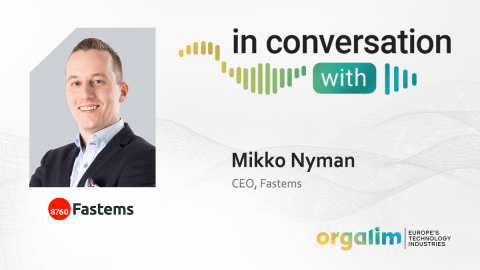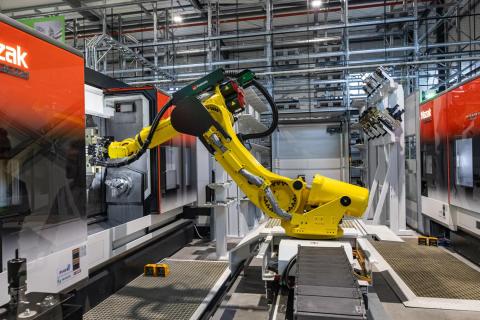In Conversation With Mikko Nyman, CEO Fastems
14 November 2023

Europe will not be able to achieve its net-zero goals without the broad deployment of advanced manufacturing and digitalisation technologies across its industries. Fortunately, many European companies are leaders in these technologies, among them Fastems, an Orgalim corporate member based in Tampere, Finland, that provides intelligent automation solutions for high-mix manufacturing. We talk to CEO Mikko Nyman about how the company’s technology solutions are making competitive and sustainable manufacturing a reality.
The EU recognises that a competitive and sustainable European manufacturing industry is essential to achieve the net-zero transformation. How does Fastems contribute?
Fastems is a global leader in intelligent automation for high-mix milling and turning manufacturing. Our customers are manufacturers in a wide range of industrial sectors, making parts for aerospace turbines, windmill gears, hydraulic systems, heavy vehicles and more. We partner with them to implement flexible manufacturing systems (FMS), something in which we have over four decades and 5,000 installations of experience.
How does this contribute? Intelligent automation builds sustainability by enabling just-in-time production of just the right quantity of parts, increasing resource and energy efficiency, decreasing waste, and cutting floorspace usage and hence building and utility costs. Our world-leading solutions are designed with the global trend of mass customisation in mind, making high-mix manufacturing economically viable and competitive anywhere in the world, including in Europe where the labour shortage and cost issues are hard to solve. Automation is a win-win for the manufacturing industry and for people, because when done right, it offers more meaningful, less stressful, and safer jobs.
Intelligent automation builds sustainability by enabling just-in-time production of just the right quantity of parts, increasing resource and energy efficiency, decreasing waste and cutting floorspace usage.
Fastems’ approach in automation goes beyond just placing robots in front of machine tools. To achieve optimal efficiency and flow in high-mix manufacturing, one must automate production planning and production resource management as well. We also integrate various software and supportive devices, to increase the automation rate further. The goal is to enable our customers’ manufacturing to do only the right things at the right time – all the time. In numbers, that is 8760 hours per year, hence our logo.
Let’s dive right in to make this vivid – can you give us an example?
We have just finished a visionary delivery at Rodin Machining, a Dutch contract manufacturer located near Amsterdam. They have developed an online portal where their customers can get a quote online for their machined parts in under a minute, and then receive those parts quickly.
This unique business model is possible thanks to a highly autonomous flexible manufacturing system where the only manual tasks are material input/output, creating the computer-aided manufacturing (CAM) file and pre-setting tools.
The system works both in milling and turning applications, and it can introduce new parts to production without disturbing the current operations and without human intervention around the computerised (CNC) machines or robots. The level and type of automation is world-leading, and it means Rodin can get replacement parts to customers very quickly and efficiently, improving production flow and lead times at the customer’s factory.

What order of efficiencies are we talking about? With a typical flexible manufacturing system with two integrated machine tools running on utilisation rates upwards of 60% each, the system can replace six stand-alone machine tools that can’t yield more than about 20% of utilisation. This equates to a savings of up to 538 tonnes CO2 equivalent during the investment phase alone, based on less machine tools and space use. Added to that, the smaller footprint creates yearly savings in utility costs and related emissions. As for productivity, one of our customers, for example, doubled their production output with the same number of employees and more than doubled their sales revenues in just a few years.
I should add that, in our own operations, we are calculating our carbon footprint annually and are working to reduce it in accordance with the science-based targets initiative (SBTi).
Looking ahead, what do you see as the emerging needs and trends in manufacturing, and what are the challenges? How do you keep driving competitiveness?
Our customers are essential to our ability to keep innovating and driving competitiveness. Fastems is fortunate to have great relationships with many of the world’s leading manufacturing companies, from Lockheed Martin to BAE Systems, Wärtsilä, AGCO corporation and ABB to name a few. By listening to them and co-developing their manufacturing visions, we are constantly innovating at the cutting edge, and pushing that edge forward.
Today, as we already discussed, the message from the markets is about increasing complexity: more product variants, more complicated parts, more demand shifts, and tighter lead time and quality requirements. At the same time, there is the need to address the labour shortage, near-shoring and sustainability.
Despite the decade-long hype, especially in high mix manufacturing, the opportunities of automation are not yet realised often enough.
Flexible, intelligent automation is the solution to all of this, and the trend is clearly towards ever more automation and connectivity, and replacing rule-based automation with intelligent, goal-based automation for greater autonomy. The shift is possible only if automation is in total control of the manufacturing process, through manufacturing management software (MMS), which runs the production and guides the operators according to customer order delivery needs.
As for the challenges, one fundamental issue is making sure these advanced manufacturing technologies are accessible and taken up by manufacturing companies. Despite the decade-long hype, especially in high-mix manufacturing, the opportunities of automation are not yet realised often enough.
On our side, this requires both productisation and continuous thought leadership in explaining the opportunities and logic of intelligent automation, which we do through webinars, open houses and infographics.
What about on the policy side? Fastems is an Orgalim corporate member and a member of our Executive Forum for Advanced Manufacturing, so clearly you see EU policy and regulation as very important for your business. What can help and what hinders, in terms of policy, from where you’re sitting?
Policy indeed matters, which is why Fastems is grateful to be an Orgalim corporate member and I am a member of the Executive Forum for Advanced Manufacturing as well. In the Executive Forum, we recently issued a statement urging European decision-makers to do more to encourage the widespread deployment of advanced manufacturing technologies and highlighting three broad policy priorities for action.
Among those priorities, from our perspective, support for functioning and trustworthy manufacturing data spaces is particularly key, because we see that companies still perceive a lot of risk when it comes to the data sharing that is an essential part of shifting to intelligent automation.
In fact, we need to be creating a much more conducive environment for investment into advanced manufacturing generally. And that includes addressing the mounting administrative burden of EU regulations, which we feel keenly as a medium-sized company. The threshold for SMEs in Europe is set so low that it mostly ignores mid-cap companies like ours, and the regulatory burden jumps massively when you cross that threshold. Our administrative obligations, as a company of around 500 employees and €100m in revenue, are the same as a big global company with thousands of employees and billions in turnover.
Overall, when it comes to policies related to industrial investments, being transparent and predictable is what companies appreciate from the authorities. Finally, we see a chance for uplifting the EU-level spirit of development as a proper response to the complexities – and sometimes even cynicism – suggested by the last decade. Investments are about the future, so we need to actively lead and tell a meaningful story about it, especially when the way forward isn’t so obvious.
Read more:
EU high-tech leaders highlight priorities to fortify Europe's advanced manufacturing edge
Photo: Robot serves two multi-tasking turning machines at Rodin, enabling unmanned high-mix manufacturing (credit: Matti Nenonen, Fastems)